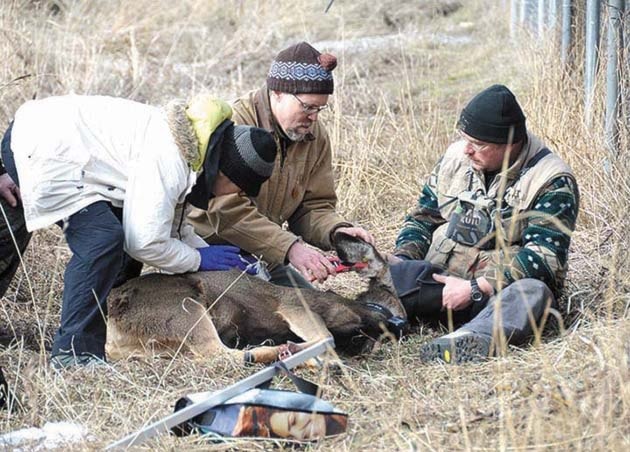The East Kootenay Urban Mule Deer Translocation Trial is proceeding, with plans to remove about 15 to 20 more deer from Kimberley and Cranbrook within the next few weeks. Those deer will be tracked by utilizing GPS collars retrieved from mortalities from the first group of animals translocated last year.
The trial is not complete — Ian Adams, the Cranbrook-based wildlife biologist who is coordinating the project says there will be a report out this summer.
“We want to follow the deer translocated in 2016 through one full cycle of seasons – i.e. through the current late winter / spring,” Adams said.
However, some key issues have been identified.
One of the questions is where is the best place to locate the deer once moved?
There doesn’t appear to be any particular pattern to where the deer move once translocated. Some deer have moved great distances, some have not.
“Some deer have stayed in natural habitats and not encountered human developments, while others have found communities and campgrounds and settled into their new ‘home towns’,” he said.
And the latter is exactly what they don’t want to see.
“From the outset, the Province has been clear that it is not looking to translocate ‘the problem’ of habituated urban deer to other communities. How to deal with those deer that have moved into new communities has been problematic.
“Three aggressive deer that were putting public safety at risk have been put down in developed areas, including Montana” says Adams. “We’re closely monitoring a couple of others that have generated complaints.
“However other collared deer have encountered communities, such as Eureka, MT, but moved on without causing problems. Other deer have exhibited natural mule deer behaviour of migrating to higher elevations in the summer before returning to lower elevation winter range last fall.”
But it’s tough to find a release site that won’t put the deer in contact with human settlement.
“The Koocanusa area has some great winter range, but unfortunately also has too many opportunities for the translocated deer to access human developments and revert to their urban habits,” Adams said.
“We also want to look at other release site options. 10 of the 22 radio-collared mule deer that were released at sites south of Highway 3 have been in Montana at one point or another, reaching as far south as Libby. Montana state wildlife officials have been very cooperative and interested in the study, but British Columbia does not want to export translocated urban deer south of the border.
“Winter range is largely at low elevation in the Trench. That’s also where we reside and build our homes and communities.” Finding suitable sites to release larger numbers of deer while minimizing the chances of habituated deer encountering other human developments will be very challenging.”
Also of importance is mortality of translocated deer. So far the mortality rate for the collared deer that were released last year is about 50 per cent, while it’s only 20 per cent for collared non-urban mule deer. That mortality includes deaths of all collared deer, including those that were euthanized.
“We had some initial predation, mostly by cougar, in spring 2016 which was consistent with non-urban mule deer populations. Spring is when they are most vulnerable.” No predation occurred after early June until a deer was killed by a carnivore near Lake Koocanusa in mid-February.
Three deer died in the late autumn of unknown causes, possibly related to poor nutrition. “All three were very thin,” notes Adams. “At least one was very old.” Determining cause of death is key, particularly for the animals that are found in poor body condition. Full testing of recovered deer mortalities has yet to be conducted. It’s very important that translocation maximizes humane animal care and that deer are able to find natural feed sources and use them effectively.
So the question is; can translocation be a tool for urban deer management?
“That’s the big question,” Adams said. “And difficult to answer. The two big questions at this point are:
1. What do we (“we” meaning a broader society, not just wildlife managers) do with deer that are translocated and arrive in another community. Like the municipalities where the deer come from (Kimberley, Cranbrook, etc.) there are varying levels of acceptance of habituated deer in the communities where the translocated deer show up. In that sense, translocation is only moving the problem from large centres to smaller ones and that is not an acceptable practice. I think there will always be some individual deer who become very habituated and prone to aggressive behaviour. Those deer are unlikely to be good candidates for translocation, but identifying those individuals when you want to capture and move them is difficult.
2. Is moving deer humane? The process is stressful (being captured, transported and dropped into an unfamiliar location and conditions) and not deer may be capable of adapting to a non-urban existence (e.g. avoid predators, choice of foods, find seasonally-appropriate habitats). When deer are captured, we have no way of knowing how that individual will respond. Not unlike people. You drop some of us off in the woods and they’re fine, others are in big trouble.
“Overall, we need to decide what is considered humane treatment for the deer. Some will argue a quick kill during an urban cull is humane, others will argue that deer should be given a chance, others will contend that translocating deer is little more than moving the problem on to someone else. Unfortunately there’s still on easy answer!
